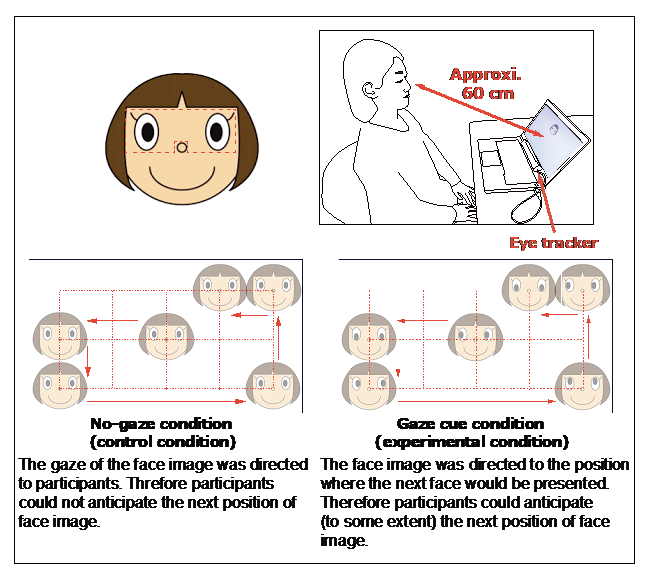The research group consisting of Makoto Wada, Director of the Developmental Disorder Section, Department of Rehabilitation for Brain Function, National Rehabilitation Center for Persons with Disabilities, and Takao Fukui, Associate Professor, Faculty of System Design, Tokyo Metropolitan University, has announced that they have clarified a way for individuals with autism spectrum disorder (ASD) to use gaze clues with only a small amount of practice. They had patients with ASD attempt the task of chasing face illustrations that are intermittently displayed one by one on the PC screen. Through this, it was confirmed that the time it takes for individuals with ASD to pay attention to the eye area of the illustration, the ultimate destination for their gaze, is quickly shortened to the amount of time it takes for a person of typical development (TD) to look at the same area. It is expected to be effective in leading to the development of training programs and support systems for individuals with ASD. The results were published in an international scientific journal, Scientific Report.
ASD is a developmental disorders characterized by less frequent eye gaze alignment with others. Gaze avoidance makes it impossible to read the partner's intention using eye gaze as a cue, which is thought to contribute to communication difficulties. There are also reports that individuals with ASD have excessive activity in the amygdala, making them feel more afraid of facial images than TD individuals. On the other hand, it was not clear why individuals with ASD are less likely to look directly at another person. It was also unclear whether this could be improved by training.
To tackle this issue, and in an effort to develop a support program for ASD individuals, the research group verified whether their performance could be improved by performing a joint gaze task (a detection task in the direction of the line of sight) for a short time (within 15 minutes). Since the patients with ASD had already informed the researchers that facial photographs trigger avoidance, whereas drawings of faces reduce the psychological burden they feel, the researchers decided to present their subjects with line drawing illustrations of faces. Ten individuals with ASD and ten TD individuals participated in the experiment and were asked to perform an eye-tracking task in which one facial image was displayed every second on a PC screen. Two tasks were prepared (one trial consisting of 16 movements). In the first task, the eye gaze of the face image was always pointing forward (no eye-gaze cue condition: control) and in the second task, the gaze of each image was pointed in the direction of the next face that would be displayed (eye-gaze cue condition: experimental condition). Participants alternated between the two tasks for a total of 20 trials to avoid experience impacting the results.
During the execution of the task, a gaze measurement device was used to determine which area of the face image the participant was looking at. The time required for the participant to direct his/her gaze to the eye area was also measured. The findings were used to develop an index of how much information (eye gaze information) expressed in the eye of the face image was utilized to carry out the task. Five trials of each condition, split into two halves, were analyzed separately to determine the changes in performance.
The results showed that the time spent gazing at the eye area during the task was shorter in patients with ASD than in TD individuals. These findings concurred with previously reported results. In contrast, it was clarified that by completing the task trials in the first half of the experiment, even patients with ASD were able to move their eyes to the eye area, which included gaze cues, as quickly as the TD individuals in the second half of trials. In the first half of the experiment, individuals who were neurotypical used gaze information in the eye area quickly, while patients with ASD did not use much gaze information.
These results indicated that the individuals with ASD could utilize the eye gaze cue after only a short practice, and the possibility that practice was useful for the improvement of communication difficulty was shown. Dr. Wada said, "It has been reported that it becomes easier for individuals with ASD to communicate by conveying their facial expressions through illustrations and mediating avatars that are replaced with animals. However, in this trial, it was found that patients with ASD were also able to utilize the line-of-sight information after practice. In the future, I would like to verify whether training using VR and associated technology is possible. We aim to develop training programs and support systems that will enable individuals with ASD to communicate more smoothly using game tasks and the like."

Credit: Makoto Wada, National Rehabilitation Center for Persons with Disabilities Department of Rehabilitation for Brain Functions
This article has been translated by JST with permission from The Science News Ltd.(https://sci-news.co.jp/). Unauthorized reproduction of the article and photographs is prohibited.




